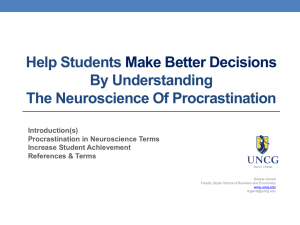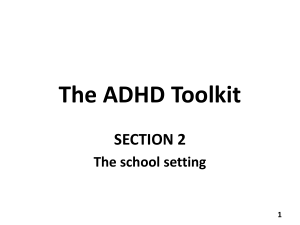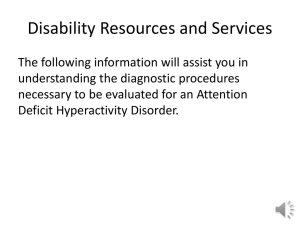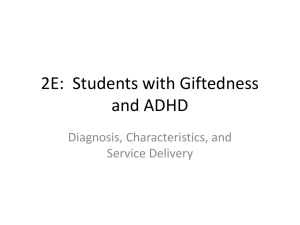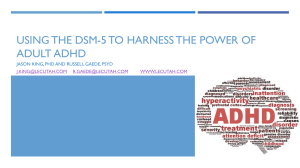Neuropharm Presentat..
advertisement
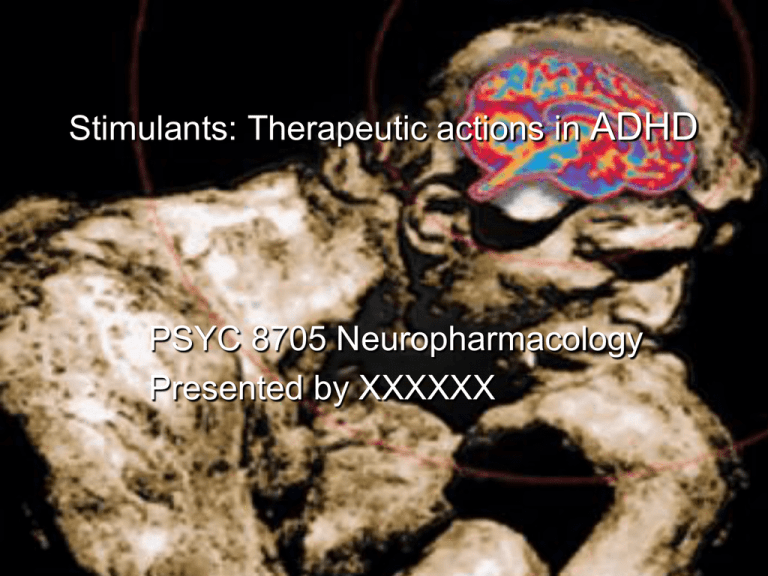
Stimulants: Therapeutic actions in ADHD PSYC 8705 Neuropharmacology Presented by XXXXXX General Roadmap Therapeutic actions of stimulant administration both for animal and human subjects Highlight the importance of prefrontal cortex as an area of pharmacological intervention for individuals suffering from ADHD Similarities between studies on animal subjects and humans Extending the literature: Kuczenski and Segal’s (2002): Rodent model Old assumption: Animals and humans differ in their responses to stimulants Rats: When administered with high doses of stimulants, dopamine was released in the ventral and dorsal striatum of the rat’s brain and resulted in locomotor hyperactivity. Human: Subjects who were being treated for ADHD using stimulant medication responded with reduced locomotor activity and an ability to better concentrate. Clients with ADHD vs. ‘normal’ Old assumption: Differences between the effects of stimulants on ADHD and ‘normal’ individuals. Paradoxical calming effects on ADHD patients. ‘Normal’ individuals taking the same dose reported simulating effects. It’s the dose not the species Kuczenski and Segal’s (2002) significantly extended the literature by directing a greater attention to the dose of stimulants that was administered to rodents and humans. Doses administered to rodents far exceeded the equivalent doses administered to humans with ADHD Given lower doses, both rodents and humans responded with the same behaviors (e.g. decreased locomotion; little effect on dopamine release). Norepinephrine I: Release NE: Enhances cognitive functioning in PFC by acting on postsynaptic α2A receptors Kuczenski and Segal (2002): Release of norepinephrine in the hippocampus (-> greater research attention on NE). Berridge et al (2006): High levels of catecholamine release in the prefrontal cortex ADHD medications most commonly affect the pre-frontal cortex rather than the subcortical areas. Significant because neither PET nor SPECT ligands were able to detect catecholamine release in the cortex. Norepinephrine II: Blocking Monkeys: Blocking α2A receptors in the PFC erodes delay-related cell firing and creates symptoms similar to those of individuals with ADHD. Conclusions: 1. Genetic mutations in NE synthetic enzymes (DBH) or the α2A receptors may contribute to ADHD by weakening the endogenous noradrenergic α2A adrenoceptor signaling. 2. High levels of NE release (e.g. during stress) impair prefrontal functioning through action at the α1 receptors Prefrontal cortex Prefrontal cortex: Attention, working memory, planning, impulse control, inhibition of responses to distractions, mental flexibility, and the ability to monitor actions Lesion studies: 1. Ventromedial prefrontal cortex: Emotion dysregulation (Anderson et al., 1999) Distractability (Godefroy & Rousseaux, 1996) Decreased inhibition of unimportant stimuli (Yamaguchi & Knight, 1990) Decreased concentration and organization (ThompsonSchill et al, 2002) 2. Dorsolateral prefrontal cortex: Inability to shift attention (Manes et al, 2002), 3. Superior prefrontal cortex Inability to divide attention. Prefrontal cortex: Sensitive to genetic mutations & developmental abnormalities ? 1. Structural imaging studies: Smaller volume of PFC, right hemisphere, cerebellum, caudate, and corpus callosum among ADHD patients (Sowell et al, 2003; Seidman et al, 2005). 1. 2. Functional imaging studies: Reduced blood flow and metabolism in PFC Impairments of associated cognitive functioning in PFC Receptor sites? Dopamine D1, D4, D5 receptors, dopamine beta hydroxylase (DBH), and the α2A adrenoceptor gene are associated to ADHD (Park et al, 2005) Polymorphism: Ineffective/excessive catecholamine receptor stimulation can result in severe cognitive impairments associated with the PFC (Arnsten & Robbins, 2005). Dopamine (D1 and D5): 1. Humans: Greater DA release during stress impairs memory and attention regulation in humans (Arnsten et al, 2005) 2. Monkeys: Stimulation of D1/D2 receptors during a spatial working memory task Moderate: Improved inhibition + enhanced spatial tuning High: Suppressed inhibition + eroded spatial tuning Conclusion: Mutation/impairment of DA receptors -> impairments in behavior regulation. Critical Review I Pervasive lack of information: Research questions or research purpose are missing, which makes a purposeful review difficult. Little information about the studies supporting the author’s argument (sample size, participant variables, and empirical or not). Little discussion of the reviewed studies which makes a critical analysis of the author’s research rationale very difficult No exploration of alternate explanations (Better: Present why the proposed theory seems more plausible than alternate explanations). No statement describing the relevance of the findings for the treatment of ADHD Critical Review II Causality (see p. 2378). : Author implies causality without the proper support (For example, just because individuals with ADHD are impaired on the same tasks as patients with prefrontal lesions, ADHD is not automatically associated with prefrontal dysfunction). Reduced volume (see p. 2378): It is not mentioned whether the reduced volume of those brain regions is relative to the remaining brain regions or can be attributed to an overall smaller sized brain. Compare to gender studies: The size does not necessarily increase functioning. Better: Investigate whether those smaller portions of the prefrontal cortex still maintain their intended function. Critical Review III 1. Unrelated information: α1 receptor blockers such as Prozosin are used in the treatment of PTSD (p.2380). Unclear: How are the actions of NE on α1 receptors, as seen in PTSD treatment, related to the actions of the same neurotransmitter on a different kind of receptor, even if that receptor belongs to the same receptor family. 2. ADHD and bipolar disorder are often confused during diagnosis (p.2380): It is unclear how this information relates to ADHD. Conclusion Despite the lacking discussion of the research findings and a missing research purpose, the arguments presented in the article appear to follow each other logically and provide a good overview of the effects stimulants have on prefrontal function and catecholamine receptors. Using lesion studies to simulate developmental abnormalities and genetic mutations might be too unspecific but those studies provide important indicators for the effects of the simulated receptor dysfunction for cognitive abilities among both human and animal research subjects.


